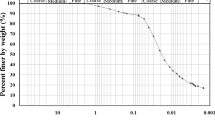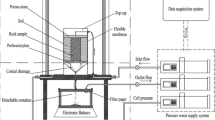Abstract
A comprehensive experimental study was conducted to evaluate the effects of soil properties and the rip-rap as well as cohesive and non-cohesive soil material and the riprap particle size on the breaching process and the failure mechanism of the levee. The results showed the crucial role of the riprap coverage and the soil properties in the breaching of the protective levees. In this regard, breaching was developed in both vertical and transverse directions. In the levee without riprap coverage, breach development was observed in the transverse direction while the levee was eroded in the streamwise direction. In contrast, in the levee with riprap coverage, breach development mainly occurred in the vertical direction. Furthermore, the flow rate across the breach was higher in the tests with no riprap compared to those with the riprap coverage. Comparisons suggested that the shorter the failure time, the longer the equilibrium time. The present research has some major implications for coastal and hydraulic engineering designs since the construction of levees is of great importance. Furthermore, the findings can be used to predict flooding and erosion induced by the embankment failure.








Similar content being viewed by others
Availability of Data and Material
All data are presented in the manuscript, there are no further data.
References
Atayee AT, Pagán-Ortiz JE, Jones JS, Kilgore RT (1993) Study of riprap as scour protection for spill-through abutments. Transp Res Rec 1420:40–48
Bahmanpouri F, Daliri M, Khoshkonesh A, Namin MM, Buccino M (2021) Bed compaction effect on dam break flow over erodible bed; experimental and numerical modeling. J Hydro 125645. https://doi.org/10.1016/j.jhydrol.2020.125645
Behrouz M, Alimohammadi S (2016) Risk-based design of flood control systems considering multiple dependent uncertainties. Water Resour Manag 30:4529–4558
Bomers A, Schielen RMJ, Hulscher SJMH (2019) Consequences of dike breaches and dike overflow in a bifurcating river system. Water Resour Manag 97:309–334
Coleman SE, Andrews DP, Webby MG (2002) Overtopping breaching of non-cohesive homogeneous embankments. J Hydraul Eng 128(9):829–838
Elalfy E, Tabrizi AA, Chaudhry MH (2018) Numerical and experimental modeling of levee breach including slumping failure of breach sides. J Hydraul Eng 144(2):04017066
Elkholy M, Sharif YA, Chaudhry MH, Imran J (2015) Effect of soil composition on piping erosion of earthen levees. J Hydraul Res 53(4):478–487
Feliciano Cestero JA, Imran J, Chaudhry MH (2015) Experimental investigation of the effects of soil properties on levee breach by overtopping. J Hydraul Eng 141(4):04014085
Franca MJ, Almeida AB (2004) A computational model of rockfill dam breaching caused by overtopping (RoDaB). J Hydraul Res 42(2):197–206
Ghazavi R, Vali A, Eslamian S (2010) Impact of flood spreading on infiltration rate and soil properties in an arid environment. Water Resour Manag 24:2781–2793. https://doi.org/10.1007/s11269-010-9579-y
Johnson EB, Testik FY, Ravichandran N, Schooler J (2013) Levee scour from overtopping storm waves and scour counter measures. Ocean Eng 57:72–82
Kaurav R, Mohapatra PK (2019) Studying the peak discharge through a planar dam breach. J Hydraul Eng 145(6)
Khoshkonesh A, Nsom B, Bahmanpouri F, Dehrashid FA, Adeli A (2021) Numerical Study of the Dynamics and Structure of a Partial Dam-Break Flow Using the VOF Method. Water Resour Manag. https://doi.org/10.1007/s11269-021-02799-2
Michelazzo G, Oumeraci H, Paris E (2018) New hypothesis for the final equilibrium stage of a river levee breach due to overflow. Water Resour Res 54:4277–4293. https://doi.org/10.1029/2017WR021378
Morris MW, Kortenhaus A, Visser PJ, Hassan MAAM (2009) Breaching processes: A state of the art review. FLOODsite Rep. T06–06–03, FLOODsite Consortium. www.floodsite.net
Pan Y, Li L, Amini F, Kuang C (2015) Overtopping erosion and failure mechanism of earthen levee strengthened by vegetated HPTRM system. Ocean Eng 96:139–148
Pickert G, Weitbrecht V, Bieberstein A (2011) Breaching of overtopped river embankments controlled by apparent cohesion. J Hydraul Res 49(2):143–156
Pinto A, Fernandes LS, Maia R (2016) Monitoring methodology of interventions for riverbanks stabilization: assessment of technical solutions performance. Water Resour Manag 30:5281–5298
Roy S, Barman K, Das VK, Debnath K, Mazumder BS (2019) Experimental investigation of undercut mechanisms of river bank erosion based on 3D turbulence characteristics. Environ Proc 7(9)
Sadeghi A, Ahadiyan J (2018) Hydraulically failure mechanism of non-cohesive homogenous protective embankments by overtopping. Irrig Sci Darin Eng 41(1):115–131
Sarkar S, Rai RK (2011) Flood inundation modeling using Nakagami-m distribution based GIUH for a partially gauged catchment. Water Resour Manag 25:3805–3835
Schmocker L, Hager WH (2010) Overtopping and breaching of dikes–Breach profile and breach flow. River Flow 2010:515–522
Schmocker L, Hager WH (2012) Plane dike-breach due to overtopping: Effects of sediment, dike height and discharge. J Hydraul Res 50(6):576–586
Siebel R (2006) Experimental investigations on the stability of riprap slope protection layers on overtoppable earth dams. In Proceedings of the international junior researcher and engineer workshop on hydraulic structures (IJREWHS’06), Report CH61/06, Div. of Civil Engineering, The University of Queensland, Brisbane, Australia, Dec, pp 81–90
Sills GL, Vroman ND, Wahl RE, Schwanz NT (2008) Overview of New Orleans levee failures: lessons learned and their impact on national levee design and assessment. J Geotech Geoenviron Eng 134(5):556–565
Singh VP (1996) Dam breaching. In Dam breach modeling technology. Springer, Dordrecht, pp 27–40
Spinewine B, Delobbe A, Elslander L, Zech Y (2004) Experimental investigation of the breach growth process in sand dikes. Proc Riverflow, M. Greco, A. Carravetta, and R. Della Morte, eds., Taylor and Francis, London
Standard ASTM (2006) D4254–91: Standard Test Method for Minimum Index Density and Unit Weight of Soils and Calculation of Relative Density. Annual Book of ASTM Standards, ASTM International, West Conshohocken, PA
Sun J, Lingwei Lu, Binliang L, Liu L (2017) Processesofdike-breakinduced flows: A combined experimental and numerical model study. Int J Sediment Res 32(4):465–471
Tsakiris G, Spiliotis M (2012) Dam-breach hydrograph modelling: an innovative semi- analytical approach. Water Resour Manag 27(6):1751–1762
Van Rijn LC (1984) Sediment pick-up functions. J Hydraul Eng 110(10):1494–1502
Wei H, Yu M, Wang D, Li Y (2016) Overtopping breaching of river levees constructed with cohesive sediments. Nat Hazards Earth Syst Sci 16(7):1541–1551
Yu MH, Wei HY, Liang YJ, Zhao Y (2013) Investigation of non-cohesive levee breach by overtopping flow. J Hydrodyn 25(4):572–579
Zhong QM, Chen SS, Deng Z, Mei SA (2019) Prediction of overtopping-induced breach process of cohesive dams. J Geotech Geoenviron Eng 145(5):04019012
Acknowledgements
The authors would like to thank the technical stuff of the Hydraulic Laboratory of Shahid Chamran University (SCU), Ahwaz, Iran, for their assistance.
Author information
Authors and Affiliations
Corresponding author
Ethics declarations
Ethics Approval
Not applicable.
Consent to Participate
Not applicable.
Consent to Publication
Not applicable.
Conflict of Interests
The authors affirm that there is no conflict of interests concerning the publication of this paper.
Additional information
Publisher's Note
Springer Nature remains neutral with regard to jurisdictional claims in published maps and institutional affiliations.
Rights and permissions
About this article
Cite this article
Ahadiyan, J., Bahmanpouri, F., Adeli, A. et al. Riprap Effect on Hydraulic Fracturing Process of Cohesive and Non-cohesive Protective Levees. Water Resour Manage 36, 625–639 (2022). https://doi.org/10.1007/s11269-021-03044-6
Received:
Accepted:
Published:
Issue Date:
DOI: https://doi.org/10.1007/s11269-021-03044-6




